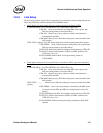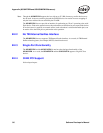
Software Developer’s Manual 393
Appendix (Changes From 82544EI/82544GC)
Appendix (Changes From 82544EI/82544GC) A
A.1 Introduction
This section describes the new features that have been added to the PCI/PCI-X Family of Gigabit
Ethernet Controllers from its predecessor, the 82544EI/82544GC and highlights its registers that
have been changed.
A.2 New Features
Following is a list of the new features in the Ethernet controller, along with sections in this manual
that describe these features in detail:
• Integrated dual-port solution. The 82546GB/EB architecture includes two instances of both
the MAC and PHY. The Ethernet controller contains a single PCI/PCI-X interface so that each
of the logical LAN devices appear as a distinct PCI/PCI-X bus device (see Chapter 12).
• IPv6 Support. The Ethernet controller supports IP/TCP/UDP receive checksum offload for
IPv6 packets, IPv6 wakeup filters, and IPv6 TCP segmentation (see Chapter 3).
• Improved Interrupts. The Ethernet controller has the following new interrupt generation
features to enhance driver performance:
— Packet timers and absolute delay timers for transmit and receive (see Section 3.2.7).
— Short packet detection interrupts (see Section 3.2.7).
— Transmit descriptor low interrupts (see Section 3.4.3).
— Interrupt throttling control to limit maximum interrupt rate (see Section 13.4.8).
— Acknowledge interrupts by writing 1b’s to the ICR (see Section 13.4.17).
• EEPROM access. Because the 82546GB/EB has two MAC/PHY instances that could
potentially access the EEPROM at the same time, a semaphore has been added to gate access.
In addition, the EERD now allows easy EEPROM access (see Section 12.3.2).
• Manageability. The Ethernet controller introduces manageability for ASF 1.0 and AOL 2.0.
• Configurable LED. The Ethernet controller enables software to customize LED displays (see
Chapter 10).
• Power Management. The internal copper PHY features 10/100/1000-BaseT signalling and is
capable of performing intelligent power-management based on both the system power-state
and LAN energy-detection (detection of unplugged cables). See Chapter 6.


















